Few references to Wallbank and its variants are found in published works on surnames. The following is from The Oxford Names Companion pub. by Oxford University Press, 2002
Wallbank Northern English: apparently a topographical name for
Someone who lived by a bank with a wall on it , from Middle English
wall + bank. Alternatively, the first element may be Northern Middle
English wall(e) spring , stream, in which case the surname would denote
someone who lived on the banks of a stream.
Vars: Wallbanks, Walbank, Walbanck(e)
Early References
Surnames were adopted in the British Isles gradually over several decades from about eight centuries ago, sometime after the Norman Conquest. By about the end of the 14th century the practice was widespread and by the time of the Poll tax in 1377,1379 & 1380 most ordinary people were identified by a surname. The earliest documented reference to Wallbank that I have found is in the Victoria County History of Lancashire Vol. 6. The Wallbank name appears in several townships near Blackburn (Church, Rishton and Billington) from the late 13th century. Robert M. Wilbanks IV refers to an Adam de Wallbank in 1332. It is likely that this is the same Adam de Wallbank appointed vicar of Blackburn, Lancashire in 1317. The Subsidy Roll of 1379 for the wapentake of Stayncliff in the West Riding of Yorkshire lists two Wallbanks. This Poll Tax return was quite thorough in recording all those subject to taxation and the return for the West Riding with 35,000 names is the most complete and legible of all the documents. The two Wallbanks are recorded in the township of Slaytburn (Slaidburn): Johannes de Wallbank & Willelmus de Wallbank (ref: National Archives , E179/206/49). A transcription of the return of 1379 for Slaytburn can be found at Genuki.
Go here for the details of the early Wallbanks
A study of the name distribution data from the earliest parish registers in 1538, through the 1881 census data, to present day data supports the notion that the name originates in the Ribble Valley region of East Lancashire/ West Yorkshire. Research elsewhere has shown that people tend to remain rooted in the locality where their ancestors acquired their surname about six centuries ago. The Wallbank and variants are probably not exceptions to this general rule. Hopefully through the continuing study of the name firmer links to the origin will be found.
An extensive search of villages , homesteads and farms has found only one locality with the name of Wallbank or variants . This is a farmstead called Wallbanks, 5 miles west of Clitheroe, Lancashire. The name can be seen on the latest Ordnance Survey (OS) 1:25000 and on the 1847 OS map. It lies between the River Hodder to the north and the River Ribble to the south, the valley of which is the region where the early parish registers suggest that the Wallbank name was most concentrated, and only a few miles from Slaidburn to the north. It is likely that the farmstead was named after one of the many local Wallbanks.
New evidence from DNA studies
Early results from the Wallbank DNA Project indicates that the name may have a multiple origin. The Lancashire / YorkshireWallbanks appear to have Viking ancestry , whereas the Staffordshire Wallbanks appear to have Anglo-Saxon ancestry. The DNA profiles of the two lines are quite distinct,but have a common ancestry more than 4000 years ago. This finding demonstrates the importance of the DNA project. Finding conclusive evidence of this dual or multiple origin is dependant on gaining more participants to the project from a broad section of regions. If multiple origin is shown to be true, it raises the question of why and how the name appeared in the secondary locations some time after the 13th century. So far, no very early references to the name in regions other than the Ribble Valley have been found The earliest reference outside the Lancashire/Yorkshire region are to be found in the church records of some Norfolk, Rutland and Staffordshire parishes in the late 16th century. These regions are associated more with the Anglo-Saxon invasion and it may therefore be regarded as more likely that they would produce person of Anglo-Saxon ancestry rather than Viking.
Variants of the Name
Name variants are very common, and it must not be assumed that because a name is spelled differently it represents a distinct line. Changes to the spelling of a name could occur for all manner of reasons, for instance: a deliberate desire to change the name, the interpretation of the spoken name by clergy recording a ceremony, etc.
This could give rise to simple variations, such as the adition of an "s" at the end of the name, the addition of an"e" at the end, one or two l's', or maybe to Wilbanks. It must be remembered that most people were illiterate as recently as 150 years ago, and translation of the spoken word to the witten word may have been done erroneouly by a person not used to the local dialect.
Where are the Wallbanks now ?
I n 2006 the total number of Wallbanks and variants in Great Britain (GB) is no more than 3000 with about another 500 in the rest of the world. This estimate is based on deductions from the data published by the Surname Profiler Project based at the University College of London. (http://www.spatial-literacy.org/UCLnames). and the 2002 National Health Service registration data extracted from the Taliesin Arlein website (Table 3 below).
Distribution and Frequency of Wallbank and variants in GB in 1998
The following maps are distributions for Wallbank variants in GB in 1998 generated from data on the Surname Profiler website. Wallbank, by far the most common variant, and Walbank is concentrated in Lancashire and the West Riding of Yorkshire. Other hot-spots are Staffordshire and Worcester. The less common variant Wallbanks is concentrated in North Staffordshire around Stoke-on-Trent, whereas Walbanks with less than 100 people countrywide falls below the current cut-off figure for the generation of the distribution map on the Surname Profiler web site.
Fig 1 Distribution and Frequency of Wallbank and variants in GB in 1998
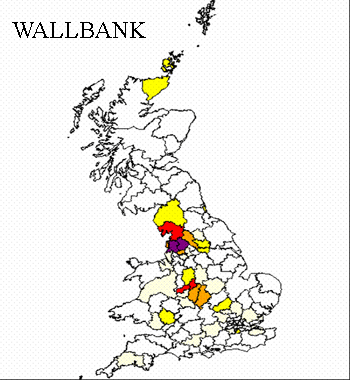 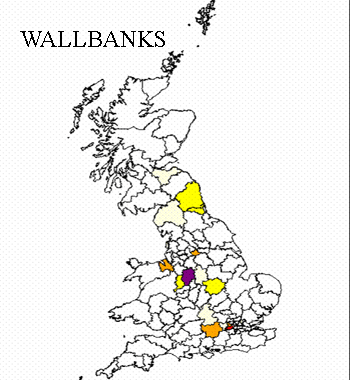 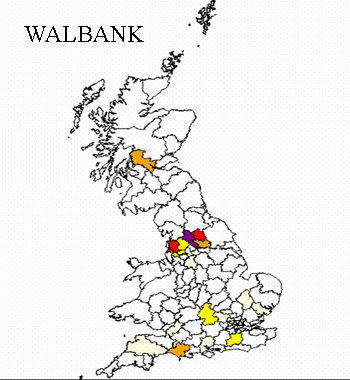
The data source for Surname Profiler is the electoral register which in 1998 held about 40 million names from a total population of about 58 million.
The frequency of the names from this register and the calculated frequency in the whole population is shown below:
Table 1 The Frequency of Wallbank and Variants in GB in 1998
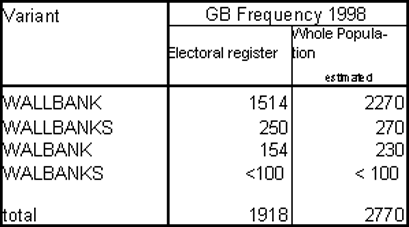
Regional differences
Most Wallbank and Walbank surnames are found in Lancashire and Yorkshire.The towns of greatest concentration of Wallbank are Preston and Clitheroe. For the much less common Walbank , Bradford is the top city. It is estimate from telephone directories that about 50% of the GB total live in these two counties. About 25% live in the Midland counties (predominately Staffordshire and Worcester) ; about 12% are found in Greater London ;and about 3% in South Wales. The few remaining are scattered across the regions. The South Wales line grew from a migrant from North Staffordshire in the 19th century .
North Staffordshire has the greatest number of the Wallbanks variant, about 50% of the total reside around Stoke-on-Trent. None, or very few, are to be found in the Wallbank hot-spot of Lancashire/Yorkshire. Reasons for this are considered elsewhere .
Overseas
Some data for US Wallbank & variants is on the North America page here. In the USA according to Surname Profiler, Wallbank has its highest share of the population in Massachusetts.
In New Zealand according to the Surname Profiler the Wall bank variant has its highest share of the population in Walkathon Province, Walbank in the Bay of Plenty, and Wallbanks in Canterbury province.
No data is published for Walbank and Wallbanks in the USA in Surname Profiler as the name appears to be extinct there.
The frequency of WALLBANK in the US, Canada, Australia and New Zealand according to Surname Profiler is shown below:
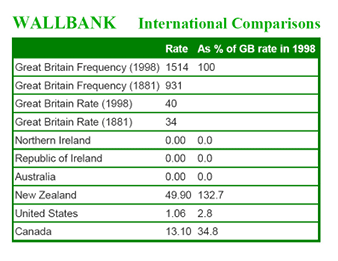
Wilbank(s) variants are found in the USA. A web page dedicated to this name can be found on Rootsweb here
The Wal(l)bank(s) in 1881
Fig 2 The Wallbank and Variant Name Distribution in 1881 by county Surname Atlas CD, Archer Software
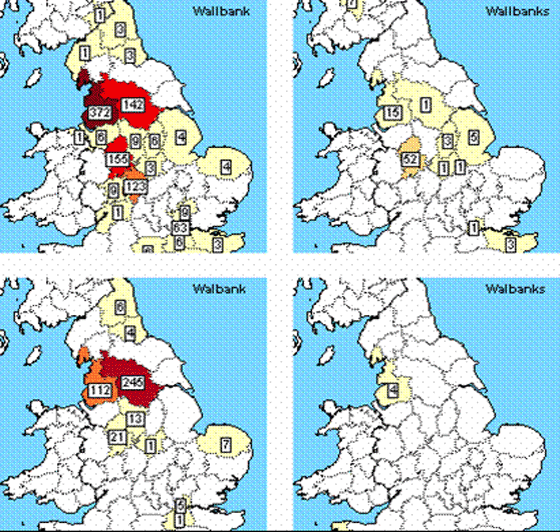
Table 2 Distribution of Wallbank and variants 1881 (Actual number by county) Surname Atlas CD, Archer Software
| County |
Wallbank |
Wallbanks |
Walbank |
Walbanks |
Walbancke |
|
|
|
|
|
|
| Cheshire |
6 |
0 |
0 |
0 |
0 |
| Cumberland |
1 |
0 |
0 |
0 |
0 |
| Derbyshire |
9 |
0 |
13 |
0 |
0 |
| Devonshire |
0 |
0 |
0 |
1 |
0 |
| Co. Durham |
3 |
0 |
4 |
0 |
0 |
| Gloucestershire |
1 |
0 |
0 |
0 |
0 |
| Hampshire |
6 |
0 |
0 |
0 |
0 |
| Hertfordshire |
9 |
0 |
0 |
0 |
0 |
| Kent |
3 |
3 |
0 |
0 |
0 |
| Lancashire |
372 |
15 |
112 |
4 |
0 |
| Leicestershire |
3 |
1 |
1 |
0 |
0 |
| Lincolnshire |
4 |
5 |
0 |
0 |
0 |
| Middlesex |
63 |
1 |
5 |
0 |
1 |
| Northumberland |
3 |
0 |
6 |
0 |
0 |
| Norfolk |
4 |
0 |
7 |
0 |
0 |
| Nottinghamshire |
6 |
3 |
0 |
0 |
0 |
| Rutland |
0 |
1 |
0 |
0 |
0 |
| Surrey |
6 |
0 |
1 |
0 |
16 |
| Sussex |
1 |
0 |
0 |
0 |
0 |
| Staffordshire |
155 |
52 |
21 |
0 |
0 |
| Warwickshire |
123 |
0 |
0 |
0 |
0 |
| Worcestershire |
9 |
0 |
0 |
0 |
0 |
| Yorks W.Riding |
142 |
1 |
245 |
0 |
0 |
| Lanarkshire |
0 |
7 |
0 |
0 |
0 |
| Roxburghshire |
1 |
0 |
0 |
0 |
0 |
| Flintshire |
1 |
0 |
0 |
0 |
0 |
|
|
|
|
|
|
| Total |
931 |
89 |
415 |
5 |
17 |
Other Variants in 1881 Census
Other variants are recorded in the 1881 census. Some ,for example Walbancke, were established several generations before the 1881 census, though they were few in number, while others such as Walback are probably misrepresentations by the census enumerator or possibly transcription errors. The full list of variants and their frequency below.
Table 3 Frequency of Wallbank and variants in 1881 GB census & Office of National Statistics (ONS) 2002 National Health Service registration data
| Variant |
GB Frequency |
| |
1881 Census |
ONS 2002 |
WALBACH |
1 |
5 |
WALBACHE |
1 |
0 |
WALBACK |
1 |
0 |
WALBACKE |
1 |
0 |
WALBANCKE |
17 |
24 |
WALBAND |
4 |
0 |
WALBANK |
415 |
164 |
WALBANKS |
5 |
0 |
WALLBACH |
6 |
0 |
WALLBACK |
1 |
0 |
WALLBANCK |
1 |
0 |
WALLBANK |
931 |
1997 |
WALLBANKS |
89 |
348 |
WELBANK |
9 |
23 |
WILBANK |
1 |
0 |
WILBANKS |
2 |
10 |
WELLBANK |
18 |
0 |
WELLBANKS |
1 |
0 |
| |
|
|
| total |
1504 |
2571 |
The table lists the frequency of the variants in 2002 using National Health Service (NHS) registration data, extracted from the Taliesin Arlein website .
Comparison of the data from 1881 and 2002 reveals that some of the name variants taken from the transcription of the 1881 census by the National Archives & Church of the Latter Day Saints did not survive to 2002 . Those names that are apparently extinct in 2002 were probably either enumerator errors in 1881 or recent transcription errors.
The apparent reduction in the incidence of Walbank is probably accounted for to some extent by the whim of the enumerator or subsequent generations of name-holders deciding to write one or two Ls. Similar whims probably account for the threefold increase in Wallbanks.
The Walbancke variant appears in some early registers and was found only in London in the 19th century.
Wal(l)bank(s) Name Distribution from 1538 to 1850
The International Genealogical Index (IGI) provides a wealth of data from which the surname distribution of the Wallbank variants can be plotted and the most likely place of origin of the name deduced. The majority of the English parish records have been transcribed by the Church of Latter Day Saints (LDS) either from the Parish Registers or from Bishop's Transcripts (or both). The Parish Registers started in 1538
but for most parishes are not complete for a variety of reasons, such as poor record keeping by the clergy and loss. Many registers were suspended during the Commonwealth period. The IGI contains proportionately fewer records after the early 19th century .Even so, enough data is available to give a reasonably accurate picture of the distribution of the surnames during the period 1538 to 1850. Over 3000 Wallbank and variants were extracted for this distribution analysis.
The distribution for England during the period 1538-1850 clearly shows how the hot-spots of today , the
Ribble
Valley
in Lancashire & Yorkshire and Staffordshire developed and how little the name has moved geographically during this period.
Wal(l)bank(s) Name Distribution 1837 to 1915
Registration Data Maps
Map1. The frequency & distribution of WAL(L)BANK(S) marriages 1837-1915
Map2. The frequency & distribution of WALLBANK births 1837-1899
Map3. The frequency & distribution of WALBANK births 1837 -1911
An analysis of the marriage registration data for Wallbank and variants from 1837 to 1915 (Map 1) confirms that Wal(l)banks were concentrated in the Ribble area of Lancashire and West Yorkshire in the 19th century. This period saw the climax of the industrialisation of Britain and with it the movement of people from the land to the rapidly expanding industrial cities. In Staffordshire, the Ellastone and neighbouring Wallbanks moved west to Potteries and south to the Black Country and Birmingham areas. Data from the IGI shows that the movement to the Birmingham area actually started a century earlier. The increasing number of Wal(l)bank(s) in the emerging areas is probably in proportion to the increase of the general population..
The Walbank variant appears to be predominantly, though not exclusively, a product of the Ribble valley area. Map 3 shows the concentration in three neighbouring registration districts ( Preston, Clitheroe and Keighley) where Walbank co-exists with the locally less numerous Wallbank (Map 3). As we saw above nationally the variant gradually reduced from about 30% of the total Wallbank variants in 1881 to less than 10% of the total variants today.
Wal(l)bank(s) Name Distribution in the National Burial Register, (1571 to 1908)
(3rd ed CD, Federation of Family History Societies)
A pdf map of the distribution is here.
Wal(l)bank(s) Name Distribution in the British Censuses 1841 to 1901
This data is presently being collated for the name variants by county for each census year. The data for the 1841 and 1851 censuses is here.
Wilbanks
Wilbanks and variants are predominantly of United States origin and according to Robert Wilbanks IV the name is an uniquely Americanised derivative of Wallbank immigrants in the 17th century. By far the vast majority of Wilbanks are found in the US though it is not uniquely American as there are at least 10 Wilbanks in England in 2002. The UK Wilbanks probably originated from a registrar's or clergyman's interpretation of the Wallbank name or maybe they are Wilbank immigrants from the US.
A web site dedicated to Wilbanks family history is here
|